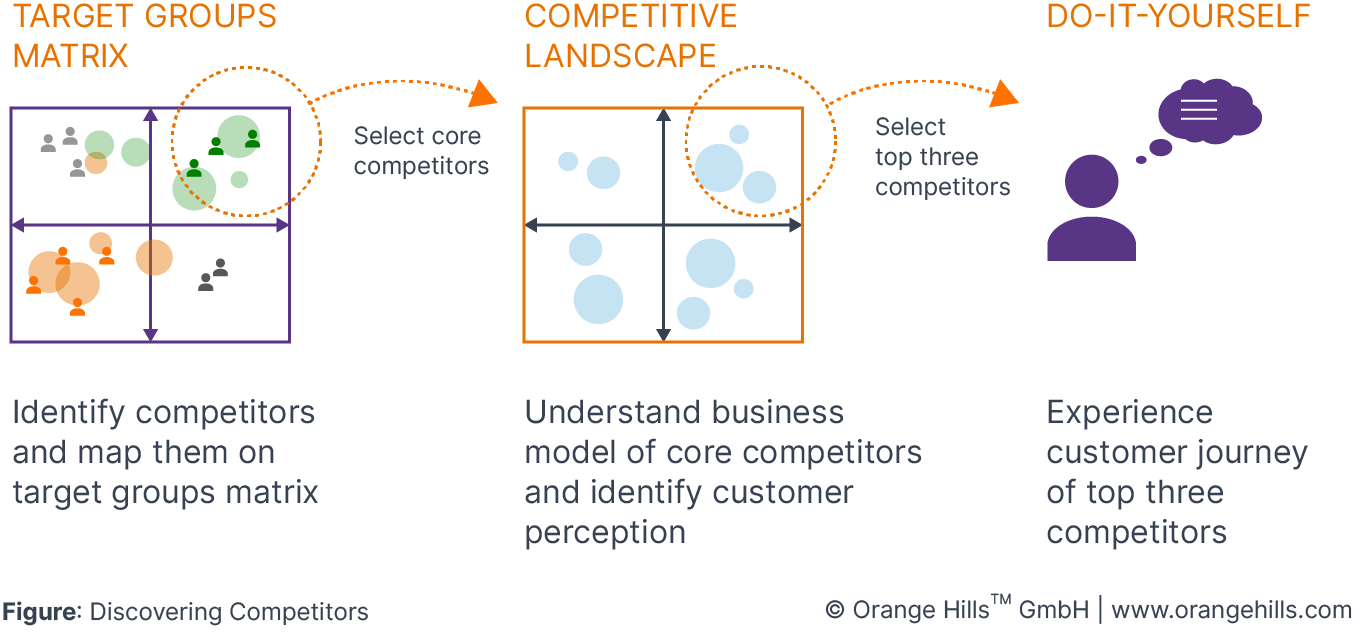Discovering Competitors
This article shows sprint teams in the Discover Phase how to discover competitors as basis to find their sweet spot in the Design Phase. Next to describing key activities, we provide tools to support the analysis.

Sabine Schoen
Business Design Field Researcher
1. Purpose
Discovering competitors is a core activity to explore your innovation space and goes hand in hand with Discovering Customers. Your starting point should be your Target Groups Matrix. Who else is currently helping your target group(s) to get their job done? Have a look at the video on this page with the example of the milkshake which is competing with a banana instead of other milkshakes. With this research question in mind you should begin discovering competitors through the eyes of your customers.

The first step is usually desk research to identify relevant competitors and map them to your Target Groups Matrix. Depending on your selected target group you get familiar with your core competitors within your target group segment. The Competitive Landscape allows you to analyse competing factors within this segment. The second step to generate more detailed insights is to immerse yourself in the competitive landscape from the customers’ point of view by the help of DIY activities, e.g. ordering and using the products of your top 3 competitors. Your insights from these activities will fuel your discussions in the Design Phase about finding the right positioning for you and your new market offerings and help you to define a Business Model supporting this positioning (see Competitive Landscape for more details about the positioning on the market).
In your first iteration of a Business Design sprint, you discover competitors from a broader perspective than in the second or third iteration due to your increasing level of knowledge. That is quite normal. Just make sure you dig deep when analysing your competitors to generate surprising and relevant insights. A list of your 100 potential competitors is not the kind of information that helps us in the Design Phase to find our sweet spot.
2. Duration
2,5 weeks
3. Key Activities
The following activities represent the core steps to discover competitors:
Scope: Have a look at your Target Groups Matrix and map offerings of competitors (also see Target Groups Matrix Analysis here). Decide on your preferred customer segment and recall their “job(s) to get done” to scope your detailed competitors analysis. Consider every market player that focuses on the same job for the next step.
Research and structure: Research core competitors and get familiar with them. Structure your insights using the Competitive Landscape template by taking into account several competing factors. Your preceding research as input for this exercise should include at least two main parts:
Understand their business model: Identify the target group(s) your competitors are addressing, the brand & message they use to do so, the channel(s) they selected to get in touch with customers and maintain their customer relationship. Have a look at their offering(s) and the core value they create with them as well as their pricing & profit formula (e.g. by checking numbers from their annual financial statements). Finally, try to understand their unfair advantage / "magic factors" why they are successful on the market.
Identify customer perception: It is crucial for us to understand how the business model of the competitor is perceived by customers. What do their customers and users think about their offerings, pricing, customer relationship, etc? Discussions in forums and customer feedback / ratings can help you to generate insights. Can they help their clients to get their job(s) done properly? Try to find as much information as possible about it and combine it with insights from your Discovering Customers activities.
Gain deeper insights: Pick top 3 competitors and immerse yourself into their world (incl. the use of products, sales and service processes). Capture results (sound, pictures, videos) to share them with your team (e.g. photo story, customer journey incl. pains & gains). See our article about the research tool DIY for more details incl. a sample how to document results.
Review positioning: Prepare the discussion in the Design Workshop about the right positioning for you and your new market offering.
It's also fun to research your worst competitor and ask yourself what you can do better than they do. Be honest to yourself!
4. Participants
Our Deep-Dive Program for Field Researcher (DE) is specifically tailored around understanding the world of customers and users as well as competitors. Get ready for your Discover Phase and join us in our Business Design Academy.
